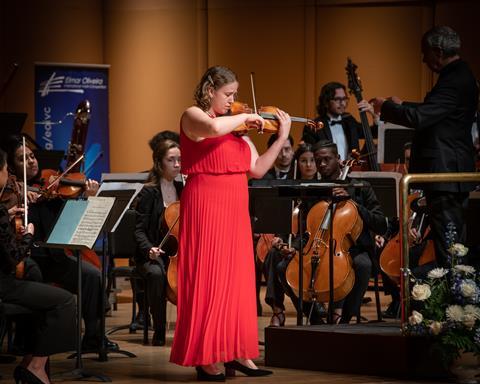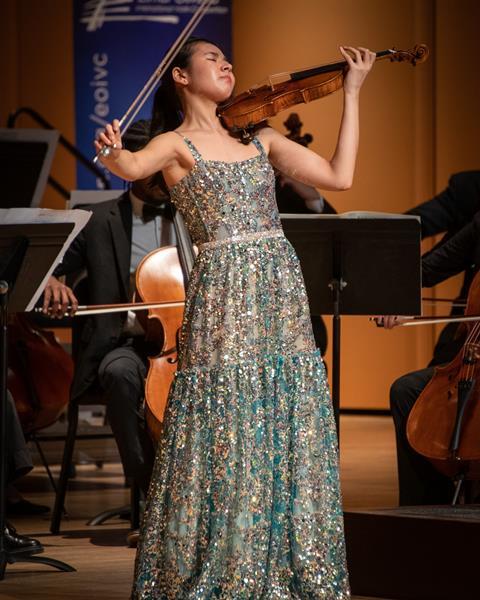In south Florida, the third triennial Elmar Oliveira International Violin Competition continued to build on its credentials for developing outstanding young talent, as Emma Baker discovered

Discover more Featured Stories like this in The Strad Playing Hub.
Read more premium content for subscribers here
Boca Raton translates as ‘mouse’s mouth’ in Spanish. But don’t let that put you off; everyone just calls it ‘Boca’, and there’s nothing ratty about this wealthy, well-heeled town on the Atlantic coast of Florida, with its long white ribbon of beach, high-end shopping avenues and affluent, mostly retired population. It may be the place for ‘snowbirds’ (the Americans who flock south in winter for warmer weather), but its proximity to Miami (40 miles south) and several universities also provide a contrasting, youthful outlook. It’s on the campus of one of these universities that the triennial Elmar Oliveira International Violin Competition (EOIVC) is held, which in January 2023 enjoyed its third edition. Oliveira, the only US violinist to win the Tchaikovsky Competition gold medal, is distinguished artist-in-residence at Lynn University Conservatory of Music and resides a little further north up the Florida coast with his violist wife Sandra Robbins.
The EOIVC is one of only two US competitions devoted to the violin that offers a career development package as well as a cash prize, the other being the International Violin Competition of Indianapolis, which the EOIVC’s chief executive Jill Arbetter affectionately refers to as ‘our sister competition’. The main prize for 2023 was a truly generous one: $30,000, a new violin by Philadelphia-based luthier Christopher Germain, a bow by Ohio maker Rodney Mohr modelled on Oliveira’s Peccatte, and a Musafia case. In addition, the winner receives – over a three-year period – at least 40 concert engagements, including recitals in New York and Cremona, plus management and career support. There is also a community engagement prize, though this had been put on hold for 2023 while Covid was still circulating.

The competition aims to identify an exceptional player based more on potential than polish, and subsequently nurture them towards an international career as a soloist. The fact that the EOIVC’s past two winners, Sirena Huang (2017) and Julian Rhee (2020) went on to win the gold and silver medals respectively at 2022’s quadrennial Indianapolis Competition shows that the judging is on to something. For 2023 the impressive jury, hand-picked by Elmar Oliveira himself, comprised chair Andrés Cárdenes, Scott Flavin, Ilya Kaler, Ida Kavafian, Irina Muresanu, Almita Vamos and Peter Zazofsky. As ever, Oliveira insisted on utmost integrity from the jury, which meant teacher-pupil links between jurors and competitors were strictly forbidden, and judging consisted of a transparent scoring system that gave every opinion equal weight.
The four finalists, who performed over the weekend of 28–29 January, had been whittled down from 20 quarter-finalists and eight semi-finalists over two weeks of live-streamed rounds from Lynn University’s Wold Performing Arts Center. For the concerto final they were accompanied by the university’s student orchestra, the Lynn Philharmonia, conducted by Guillermo Figueroa. From of a choice of seven concertos, three finalists opted for Sibelius’s Violin Concerto in D minor, and one for Bartók’s Second Concerto – a brave choice and a tricky one for reasons that later became clear.
The competition audience was largely made up of a convocation of violin-making and dealing royalty
Saturday evening saw the first two of the finalists, Gabrielle Després (Canada/US, b.2000) and Zachary Brandon (US, b.1998) both perform Sibelius. The two performances couldn’t be more different. Després played her loaned 1790 Giuseppe and Antonio Gagliano with a sweet tone and thought-out, elegant phrasing, but her third movement felt underpowered. The student orchestra did a creditable job, with excellent string playing, though the brass and woodwind were less successful, particularly during the introduction to the second movement. Brandon attacked the score with passion but seemed uncomfortable in places, though the virtuosic passages held few technical terrors for him. His approach to the final movement seemed more about sub-tropical heat than Nordic fire, but it was exciting enough for the audience to reward him with a standing ovation. He played on a G.B. Ceruti c.1770 – on loan from the New York dealer Jonathan Solars, whom I was sitting next to in the auditorium.
The competition audience was in fact largely made up of a convocation of violin-making and dealing royalty, the star of the show being collector extraordinaire David L. Fulton, who sponsored the main $30,000 prize and had flown in from Seattle to listen to the finals. I also spotted Dmitry Sitkovetsky, scouting for soloists for his Queensboro Symphony Orchestra, and Philip Setzer of the Emerson Quartet, who had been one of the preliminary selection judges. The overall mood was buoyant but the message was that the most promising young violinists need access to great instruments and bows to achieve their potential, and this is where the dealers and makers can help.

Sunday afternoon’s final pitted the eldest competitor (Laurel Gagnon, US, b.1995) against the youngest (Hina Khuong-Huu, France/Japan/US, b.2004). Gagnon stood out with her performance of Bartók’s Second Concerto, which she played on her uncredited instrument with poise and maturity, though the orchestra struggled with the huge and challenging score.
Then Khuong-Huu played Sibelius on a 1692 Stradivari owned by the Juilliard School, where she studies with Itzhak Perlman and Li Lin. Though her tuning was a little shaky in places, her sheer joy in performing the music was palpable and her communication with both her fellow musicians and the audience was outstanding. To my ears, she over-indulged in the D flat Largamente theme in the first movement, and the G-string dotted theme that opens the third movement theme felt too heavy – but then at only 18 years old, one is allowed to be a little green in judgement.
After the concert, while the judges deliberated. I chatted to one of the second violinists in the orchestra, who confided that some of her colleagues had been shaking with nerves before the Bartók. Rehearsal time had been precious, she said, and they were conscious of how vital it was to play their best for the finalists.
The placing was announced in reverse order: Brandon fourth, a result that caused some surprise, then Gagnon (perhaps choosing such a big concerto did her no favours), Després second, and Khuong-Huu first. I could understand why the jury favoured her: at 18 and brimming with promise she was perhaps the most obvious choice for a competition that is all about spotting and nurturing burgeoning talent.
Read: Winners announced for the 2023 Elmar Oliveira International Violin Competition
Read: Postcard from Kerteminde: Chamber Music at Lundsgaard
Discover more Featured Stories like this in The Strad Playing Hub.
Read more premium content for subscribers here
The number one source for playing and teaching books, guides, CDs, calendars and back issues of the magazine.
In The Best of Technique you’ll discover the top playing tips of the world’s leading string players and teachers. It’s packed full of exercises for students, plus examples from the standard repertoire to show you how to integrate the technique into your playing.
The Strad’s Masterclass series brings together the finest string players with some of the greatest string works ever written. Always one of our most popular sections, Masterclass has been an invaluable aid to aspiring soloists, chamber musicians and string teachers since the 1990s.
This year’s calendar celebrates the top instruments played by members of the Australian Chamber Orchestra, Melbourne Symphony, Australian String Quartet and some of the country’s greatest soloists.
































![[1st prize] Poiesis Quartet in round 3 (2)](https://dnan0fzjxntrj.cloudfront.net/Pictures/100x67/1/9/5/41195_1stprizepoiesisquartetinround32_547631.jpg)











No comments yet